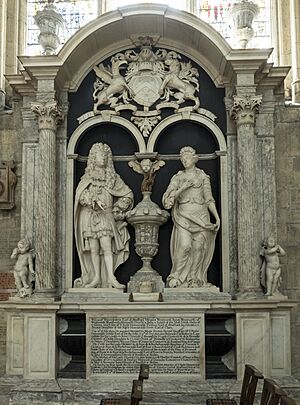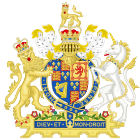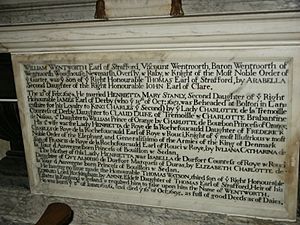William Wentworth, 2nd Earl of Strafford facts for kids

William Wentworth, 2nd Earl of Strafford (born June 8, 1626 – died October 16, 1695), was a very important landowner. He lived at Wentworth Woodhouse in Yorkshire, England. He also held the special title of Knight of the Garter.
His Early Life
William was born at Wentworth Woodhouse. He was the only son of Thomas Wentworth, 1st Earl of Strafford. His mother was Arabella Holles. She was the daughter of John Holles, 1st Earl of Clare. William's mother passed away when he was only five years old. After her death, his father married Elizabeth Rhodes. She was a kind stepmother to William and his sisters.
His Public Life
William Wentworth studied at Trinity College Dublin. In 1641, his father was executed by the government. After this, William left England for several years. He mainly lived in France. He was worried about what might happen to him. People say he worked as a secret agent for the King in Germany and Denmark. This work ended with a big argument and a duel.
Quick facts for kids Strafford Attainder Act 1662 |
|
|---|---|
| Act of Parliament | |

|
|
| Long title | An Act for the reversing the Earle of Strafford his Attainder. |
| Citation | 14 Cha. 2. c. 29
|
| Dates | |
| Royal assent | 19 May 1662 |
| Commencement | 7 January 1662 |
| Repealed | 30 July 1948 |
| Other legislation | |
| Repealed by | Statute Law Revision Act 1948 |
|
Status: Repealed
|
|
| Text of statute as originally enacted | |
In 1652, William was allowed to come back to England. He had to take a special oath to do so. In 1662, a law against his father was cancelled by Parliament. This meant William got back his title of Earl of Strafford. He also became a Knight of the Garter in 1661. He joined the Fellow of the Royal Society in 1668. This is a group for important scientists. However, he was removed from it in 1685.
William lived a quiet life. But he gave a very good speech in the House of Lords in 1667. He spoke against sending Edward Hyde, 1st Earl of Clarendon away. William argued that no crime had been proven against him. This was brave because Clarendon had been an enemy of William's father. William became a member of the Privy Council in 1674. This was a group of advisors to the King. He was at an important meeting in 1678. Here, a man named Titus Oates shared a made-up story called the Popish Plot. During a time of political trouble, William supported the future King James II. He even visited James when he traveled through Yorkshire in 1679.
William was known for being a bit relaxed and not very forceful. But his family loved him very much. His father's last letter was to "dearest Will." It was from "a father that tenderly loves you."
His Marriages
William Wentworth married two times:
- First, on February 27, 1654, he married Lady Henrietta Mary Stanley. She was the daughter of James Stanley, 7th Earl of Derby. Her mother was Charlotte de La Trémoille. Henrietta passed away before William. They did not have any children. She was buried in York Minster. William built a large monument there to remember her. This monument is still standing today.
- Second, he married Henrietta de la Rochefoucauld. She was the daughter of Frederic Charles de Roye de la Rochefoucauld. This Henrietta was buried in London in 1732.
His Death and Legacy
William Wentworth passed away in Yorkshire on October 16, 1695. He was 69 years old. He was buried in York Minster.
Strafford County, New Hampshire in the United States is named after him.
Who Came After Him
William did not have any children. He also had no brothers who lived longer than him. So, his title of Earl became extinct. However, his title of Baron Raby was passed on. It went to his cousin's grandson, Thomas Wentworth (1672-1739). This Thomas became the Earl of Strafford with a new title. William's huge land estates, including Wentworth Woodhouse, went to his younger nephew, Thomas Watson. Thomas was the third son of William's sister, Anne Wentworth. To follow William's wishes, Thomas added Wentworth to his last name.


